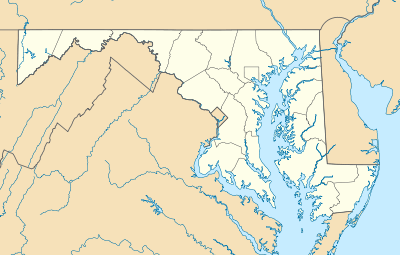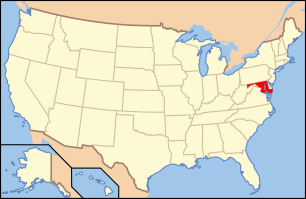Montpelier Mansion (Laurel, Maryland)
|
Montpelier | |
|
Montpelier in May 2007 | |
  | |
| Nearest city | Laurel, Maryland |
|---|---|
| Coordinates | 39°3′54″N 76°50′42″W / 39.06500°N 76.84500°WCoordinates: 39°3′54″N 76°50′42″W / 39.06500°N 76.84500°W |
| Area | 110 acres (45 ha)[1] |
| Built | 1748[2] or 1783[3] |
| Architect | Unknown |
| Architectural style | Georgian |
| NRHP Reference # | 70000852 |
| Significant dates | |
| Added to NRHP | April 17, 1970[2] |
| Designated NHL | April 15, 1970[4] |
Located south of Laurel in Prince George's County, Maryland, United States, Montpelier Mansion is a five-part, Georgian style plantation house most likely constructed between 1781 and 1785.[3] It has also been known as the Snowden-Long House, New Birmingham, or simply Montpelier.[2] Built by Major Thomas Snowden and his wife Anne, the house is now a National Historic Landmark operated as a house museum. The home and 70 acres (28 ha) remain of what was once a slave plantation of about 9,000 acres (3,600 ha).[5]
It was declared a National Historic Landmark in 1970.[1][4]
History
Richard Snowden originally migrated to America in 1658 from Birmingham, England,[6] where his family had settled for many years after originating in Wales.[7] Richard the immigrant had a son, Richard Junior (1719–1753),[8] who had a son, Richard the "iron master"[9] (d. 1763).[10] Richard the iron master acquired much wealth through an iron forge, mining local iron.[10] Richard then had a son, Thomas (1722–1770), who had a son Major Thomas (1751–1803),[11] so called because of his service in the American Revolution.[9] Major Thomas married Anne Ridgely,[11] who was raised at an earlier estate named Montpelier in Fulton, Maryland, and built the Mansion circa 1783.[3]
Their son Nicholas Snowden, who had been born at the mansion in 1786, was its next owner, until he died in 1831. (His son Nicholas N. Snowden, also born at the mansion, became a farmer next to Avondale Mill, and died at Manassas while serving in the 1st Maryland Infantry, CSA.)[12] The home then passed to Nicholas' daughter Julianna Maria who married Dr. Theodore Jenkins there in 1835. Dr. Jenkins died in 1866 and upon Mrs. Jenkins' later death, the mansion passed to her children[9] who kept ownership in the family until 1890.[3] The home was later owned by speculative investors W.P. Davis and Martin W. Chollar. In 1895, it was sold to Josephine D. Taylor of New York as a summer home. Its title went to Lewis H. Blakeman of New York in 1900, then to New York writer Edmund H. Pendleton who lived there from 1905 until his death in 1910,[9] having made it his winter home.[13] Pendleton's estate sold the mansion to Otto V. von Schrader in 1911.[9]
After a succession of other owners, mansion ownership transferred in 1928[14] to Breckinridge Long, Undersecretary of State[15] under Franklin D. Roosevelt and United States Ambassador to Italy from 1933 to 1936.[16] Long's daughter Christine L. Willcox, the mansion's last private owner,[17] donated the property to the Maryland-National Capital Park and Planning Commission in 1961. It was shown to the public as part of the U.S. Bicentennial celebrations in 1976. The same year, a barn budgeted to become a public arts center was destroyed by arson.[18] The Mansion was renovated in the 1980s with funds from a state grant. The historic home was opened as a public tourist attraction in 1985,[19] reflecting its ownership by Nicholas Snowden[5] in 1830. The mansion can be rented for conferences and weddings and the grounds serve as a cultural center, hosting special exhibitions and performances.[20]
Famous Visitors
- Abigail Adams[21]
- Franklin D. Roosevelt[16]
- George Washington, at least twice (May and September 1787) on his way to and from Philadelphia as a delegate to the Constitutional Convention[22]
- Martha Washington, on the way to her husband's first presidential inauguration in 1789[22]
- Woodrow Wilson[16]
Description
Montpelier is a five-part Georgian country house with a central block and flanking end pavilions connected to the main block by hyphens. The two-story central block has a five-bay elevation, with a projecting three-bay pavilion topped by a pediment. The hipped roof features large projecting chimneys emerging about halfway up the roofline. The front and rear doors are similar in character, with flanking pilasters and an open pediment The interior features carved woodwork. The paneling in the drawing room conceals a secret doorway leading to a set of stairs.[1]
In 1970, the house was set in formal gardens. Three terraces were outlined in boxwood hedges and arranged as an allée. A boxwood maze near the south wing was stated to be more than 200 years old.[1] Most of the boxwood hedges have since been removed. A hexagonal eighteenth century summerhouse is located at the end of the allée.[1]
Gallery
 Montpelier in May 2007
Montpelier in May 2007 The Montpelier Summer House in May 2007
The Montpelier Summer House in May 2007 The Gardens at Montpelier
The Gardens at Montpelier The Gardens at Montpelier
The Gardens at Montpelier The Gardens at Montpelier
The Gardens at Montpelier
References
- 1 2 3 4 5 Mrs. Preston Parish (January 15, 1970). National Register of Historic Places Inventory-Nomination: Montpelier / Snowden-Long House, New Birmingham (pdf). National Park Service. and Accompanying three photos, exterior, from 1970 (32 KB)
- 1 2 3 National Park Service (2008-04-15). "National Register Information System". National Register of Historic Places. National Park Service.
- 1 2 3 4 "Montpelier Mansion History". Maryland-National Capital Park and Planning Commission. Retrieved 2008-04-13.
- 1 2 "Montpelier". National Historic Landmark summary listing. National Park Service. Retrieved 2008-10-29.
- 1 2 "Historic Homes in Maryland". Self Guided Walking Tours of Women's History Sites. National Museum of Women's History. Retrieved 2008-07-15.
- ↑ Morley, Dr. L.B. (c. 1948). "Early History of Patuxent Wildlife Research Center" (PDF). Patuxent Wildlife Research Center. p. 9. Retrieved 2008-07-15.
- ↑ "Snowden and Warfield Family Genealogy Website". Dr. George A. Sheele, MD. Retrieved 2008-07-15.
- ↑ Ridgely, Helen W. (1908). Historic Graves of Maryland and the District of Columbia. New York: The Grafton Press. p. 89. Retrieved 2008-07-15.
- 1 2 3 4 5 Hammond, John Martin (1914). Colonial Mansions of Maryland and Delaware. Philadelphia: J.B. Lippincott. pp. 91–95. Retrieved 2008-07-15.
- 1 2 Hammond 1914, p. 101
- 1 2 Browning, C.H. (ed.) (1883). Americans of Royal Descent. Philadelphia: Porter & Coates. p. 190. Retrieved 2008-07-15.
- ↑ Ruffner, Kevin Conley. Maryland's Blue & Gray: A Border State's Union and Confederate Junior. p. 326. ISBN 978-0-8071-4182-3.
- ↑ Warfield, Joshua Dorsey (1905). The Founders of Anne Arundel and Howard Counties, Maryland. Baltimore: Kohn & Pollock. p. 363. Retrieved 2008-07-15.
- ↑ Lavoie, Catherine C. (February 1991). "Montpelier" (PDF). Historic American Buildings Survey. Washington, D.C.: Library of Congress. p. 6. Retrieved 2008-07-16.
- ↑ Bryant, Katherine D.; Schneider, Donna L. (1999). Images of America: Prince George's County Maryland. Arcadia. p. 47. ISBN 0-7385-0265-0. Retrieved 2008-07-15.
- 1 2 3 Colbert, Judy (2007). Maryland and Delaware: Off the Beaten Path. Guilford, Connecticut: Globe Pequot. p. 88. ISBN 0-7627-4418-9. Retrieved 2008-07-15.
- ↑ "St. George's Day Awards". Prince George's County Historical Society. Retrieved 2008-07-15.
- ↑ "Two Girls Arrested In Laurel Barn Fire". The Washington Post. 18 December 1976.
- ↑ "Montpelier". Laurel Art Guild. Retrieved 2008-07-15.
- ↑ "What Works: Best Practices for Sensible & Sustainable Growth" (PDF). A Greater Washington. November 2003. Retrieved 2008-07-13.
- ↑ "Montpelier Mansion Introduction". Maryland-National Capital Park and Planning Commission. Retrieved 2008-04-13.
- 1 2 "George Washington Really Did Sleep Here". Evergreen Press Releases. Maryland Office of Tourism. February 2004. Retrieved 2008-07-15.
External links
| Wikimedia Commons has media related to Montpellier Mansion. |
- Official website
- Montpelier, Prince George's County, including undated photo, at Maryland Historical Trust
- Historic American Buildings Survey (HABS) No. MD-140, "Montpelier, Montpelier Drive & State Route 197, Laurel vicinity, Prince George's County, MD", 50 photos, 24 data pages, 2 photo caption pages
- HABS No. surveyMD-140-A, "Montpelier, Garden House", 3 photos, 1 photo caption page


